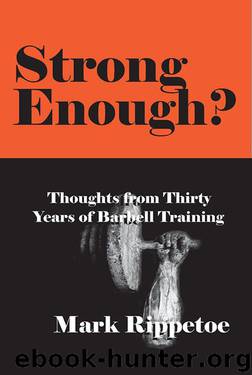Strong Enough? Thoughts on Thirty Years of Barbell Training by Rippetoe Mark

Author:Rippetoe, Mark [Rippetoe, Mark]
Language: eng
Format: epub
Publisher: The Aasgaard Company
Published: 2010-09-23T21:00:00+00:00
Barbell training has been the focus of my attention for the last couple of decades. I am not bored with it yet. Whenever I have the opportunity to train a group of interested, motivated, bright people, I learn as much as they do. It has recently come to my attention that there are objective ways to describe proper form for the basic barbell exercises that are valid for everybody that does them, regardless of their anthropometry. For example, it doesn't matter how long your femurs or how short your back, the bar is going to come off the ground in a deadlift when the bar is directly under the shoulder blades. This position will place the shoulders slightly forward of the bar and the arms at a slight angle back to it. This is a function of the mechanics of the skeleton, and is true even when form is bad: if the bar is too far away from the shins, and not right against them in a position that minimizes the torque against the hip joint, the bar still leaves the ground from a position plumb to the scapulas. Even if you wanted your back vertical due to the mistaken idea that a vertical back is "safer" than an inclined back, ultimately it doesn't matter because your skeleton cannot pull a heavy weight this way. But any correct pull from the floor — for deadlift, clean, or snatch — will start with the bar directly under the scapulas and against the shins. Any video of a heavy deadlift, clean, or snatch from the side will demonstrate this fact. It will also show that the bar leaves the ground when it is right above the middle one-third of the foot.
Why the middle one-third of the foot? Because the weight of the load is distributed over the whole plantar surface of the foot if the load is in balance, and the load in question is the combined weight of you and the bar acting at the ground directly under the center of mass (COM) of this lifter/barbell system. If the weight is disproportionately on the toes or heels, the COM is either forward or behind where it should be to achieve even distribution against the ground. When the weight is light, the mass of the body is the primary factor in balance. As the bar becomes heavier — as you get stronger — it becomes a larger percentage of the load, and the COM of the system gets closer to the COM of the bar. For this reason it is possible to do light weights with form that will be wrong, or ineffectual, at heavier weights, but heavy weights are unforgiving of errors in form that result in unbalanced loads.
Download
This site does not store any files on its server. We only index and link to content provided by other sites. Please contact the content providers to delete copyright contents if any and email us, we'll remove relevant links or contents immediately.
Tools of Titans by Timothy Ferriss(7813)
Bodyweight Strength Training by Jay Cardiello(7674)
Born to Run: by Christopher McDougall(6894)
Inner Engineering: A Yogi's Guide to Joy by Sadhguru(6440)
Asking the Right Questions: A Guide to Critical Thinking by M. Neil Browne & Stuart M. Keeley(5355)
The Fat Loss Plan by Joe Wicks(4620)
Bodyweight Strength Training Anatomy by Bret Contreras(4465)
Yoga Anatomy by Kaminoff Leslie(4100)
Science and Development of Muscle Hypertrophy by Brad Schoenfeld(3970)
Dynamic Alignment Through Imagery by Eric Franklin(3919)
ACSM's Complete Guide to Fitness & Health by ACSM(3823)
The Four-Pack Revolution by Chael Sonnen & Ryan Parsons(3791)
Exercise Technique Manual for Resistance Training by National Strength & Conditioning Association(3786)
Bodyweight Strength Training: 12 Weeks to Build Muscle and Burn Fat by Jay Cardiello(3779)
Yoga Anatomy by Leslie Kaminoff & Amy Matthews(3737)
The Ultimate Bodybuilding Cookbook by Kendall Lou Schmidt(3707)
Yoga Therapy by Mark Stephens(3570)
Nutrition for Sport, Exercise, and Health by Spano Marie & Kruskall Laura & Thomas D. Travis(3556)
Nutrition for Sport, Exercise, and Health by Marie Spano & Laura Kruskall & D. Travis Thomas(3546)
